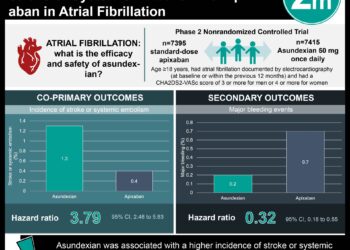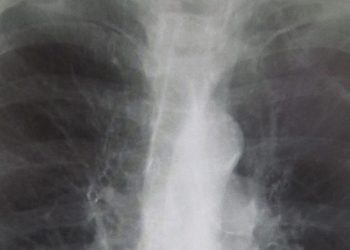2 Minute Medicine Rewind December 27, 2023
Negative Wealth Shock and Cognitive Decline and Dementia in Middle-Aged and Older US Adults
1. Among US adults over age 50, experiencing a negative wealth shock increased the risk of both accelerated cognitive decline and dementia.
Evidence Rating Level: 1 (Excellent)
Dementia is one of the leading causes of death worldwide. In this cohort study among US adults over age 50, researchers aimed to determine whether negative wealth shock has an impact on cognitive decline and dementia. Data were collected between 1996 and 2020 on participants from the Health and Retirement Study, a prospective cohort study. Negative wealth shock was defined as losing 75% or more of wealth over a 2 year period, which was assessed by quantified questionnaires. Participants’ cognitive function was determined via Telephone Interviews for Cognitive Status. In total, 8082 participants were included in this study, with a median follow up time of 14 years (IQR, 7-20 years). Negative wealth shock was found to be associated with an accelerated rate of cognitive decline (β coefficient, −0.014 [95% CI, −0.027 to −0.001]; P = .03) and greater risk of developing dementia (hazard ratio [HR], 1.27 [95% CI, 1.11-1.46]; P < .001). This association was significant among White participants and those under age 65, but not among those of other races or those over age 65. These findings may be useful in the future to improve policies for addressing economic hardship. A limitation of this study is that the causes of wealth shock were not identified. Overall, this study demonstrates that experiencing negative wealth shock increases the risks of both cognitive decline and dementia among US adults over the age of 50.
Initiation of Opioid Agonist Therapy After Hospital Visits for Opioid Poisonings in Ontario
1. Among individuals receiving care in a hospital setting for opioid toxicity in Ontario, Canada, the proportion who received opioid agonist therapy after discharge increased from 1.7% to 5.6% from 2013 to 2020.
Evidence Rating Level: 2 (Good)
In this retrospective cohort study, researchers aimed to assess the proportion of patients initiating opioid agonist therapy (OAT), including methadone, buprenorphine-naloxone, or slow-release oral morphine, within 7 days of receiving care in a hospital setting for an opioid overdose. The hospital encounters occurred between 2013 and 2020 in Ontario, Canada. In total, 20,702 hospital visits for opioid toxicity were included in this study. In 2013, OAT initiation was 1.7%. At the end of the study period, in 2020, OAT initiation had risen to 5.6%. Publication of the Canadian Opioid Use Disorder management guideline had no significant impact on the rate of OAT initiation. A limitation of this study is that researchers were unable to collect data on prescriptions for OAT that were administered on discharge but never filled. Overall, this study demonstrates that there are likely a large number of missed opportunities to initiate OAT in hospital settings.
1. Many participants who sustained a traumatic brain injury experienced no cognitive dysfunction, though more severe initial injuries were associated with a greater risk of cognitive decline 6 months of follow-up.
Evidence Rating Level: 1 (Excellent)
Traumatic Brain Injuries (TBIs) are often associated with cognitive dysfunction. The typical course of cognitive recovery during the first several months following the experience of a TBI has not previously been well established. In this prospective cohort study, researchers collected data from Transforming Research and Clinical Knowledge in TBI (TRACK-TBI). Participants included 1057 individuals over age 17 who presented to Level I trauma centers in the United States within 24 hours of sustaining a head injury between March 2014 and July 2018. Participants were categorized as having sustained an msTBI (GCS score 3-12) or mTBI (GCS score 13-15). Cognitive function was assessed 6 months after the initial TBI via performance on standard neuropsychological tests. Participants were compared to control subjects who presented to the same centers after sustaining orthopedic injuries, as well as uninjured friends and family members. 6-months following the initial injury, the majority of participants demonstrated cognitive functioning within 1.5 standard deviations compared to the control group, 49.3% of the msTBI group (95% CI, 39.5%-59.2%) and 67.5% of the mTBI group (95% CI, 63.7%-71.2%) showed no evidence of impairment. Among the individuals who experienced cognitive impairments at 6 months, effects were observed across domains of memory, processing speed, and executive functioning. A limitation of this study is that only patients who presented to Level I trauma centers were included, and as such, the data may not be generalizable to other populations who sustain a TBI. Strengths of this study include the large cohort size and the prospective study design. Overall, this study demonstrates that at 6 months following a TBI, many participants experienced no cognitive dysfunction, though a higher proportion of individuals with impairment sustained more severe initial injuries.
1. Among those with high levels of alcohol consumption, a genetic predisposition to poor alcohol metabolism increases the risk of developing atrial fibrillation.
Evidence Rating Level: 2 (Good)
Previous research has not well established whether mild to moderate alcohol consumption increases the risk of developing atrial fibrillation (AF). Some reports have speculated that genetic traits for alcohol metabolism may influence the relationship between alcohol consumption and AF. In this study, researchers aimed to determine whether genetic predisposition to poor alcohol metabolism is related to the risk of incident AF. Data was collected from the UK Biobank. 399,329 participants were enrolled in 2006 and 2010 and followed for incident AF until 2021. Polygenic risk score (PRS) tertiles were used to categorize the participants based on their genetic predisposition to alcohol metabolism. Additionally, subjects were categorized as non-drinkers, mild-moderate drinkers (<30 g/day), and heavy drinkers (>30 g/day). During the study period, 19,239 participants were diagnosed with AF. Compared to non-drinkers, those who consumed mild-moderate quantities of alcohol were less likely to develop AF (HR 0.96, 95% CI 0.92-0.99). Conversely, heavy drinkers showed increased risk (HR 1.06, 95% CI 1.02-1.10). When considering the PRS tertiles, risk of AF was no different for mild-moderate drinkers, but heavy drinkers had increased AF risk in the lowest tertile group. A limitation of this study is that alcohol consumption was determined at the study onset, but researchers did not assess whether consumption changed over the follow up period. Overall, this study demonstrates that heavy drinkers with genetic predisposition to low alcohol metabolism were more susceptible to developing AF.
1. Individuals with an intellectual or developmental disability were more likely to experience negative outcomes 80-190 days after COVID-19 infection.
Evidence Rating Level: 2 (Good)
Early in the COVID-19 pandemic, researchers determined that individuals with intellectual and developmental disabilities (IDD) were more likely to contract severe COVID-19 disease. To date, no studies have investigated the long-term effects of COVID-19 infection in this population. In this study, 36,308 participants both with and without IDD were identified from the TriNetX network, which includes subjects from Brazil, Taiwan, the United States, and Poland. Follow-up occurred over the first 90 to 180 days after COVID-19 infection. During this period, those with an IDD were more likely to develop post-COVID-19 conditions compared to those without an IDD (hazard ratio [HR], 1.120; 95% confidence interval [CI]: 1.053-1.191). These conditions included abnormal breathing, cough, fatigue, cognitive symptoms, myalgia, disordered sleep, and abdominal symptoms. A limitation of this study is that many participants with an IDD have difficulty explaining their symptoms, which may lead to underdetection or inaccurate diagnosis of post-COVID-19 syndromes. This study demonstrates that individuals with an IDD are more likely to experience negative outcomes 80-190 days after being infected with COVID-19. This vulnerable population may need more monitoring in clinical settings following COVID-19 infection.
Image: PD
©2023 2 Minute Medicine, Inc. All rights reserved. No works may be reproduced without expressed written consent from 2 Minute Medicine, Inc. Inquire about licensing here. No article should be construed as medical advice and is not intended as such by the authors or by 2 Minute Medicine, Inc.







